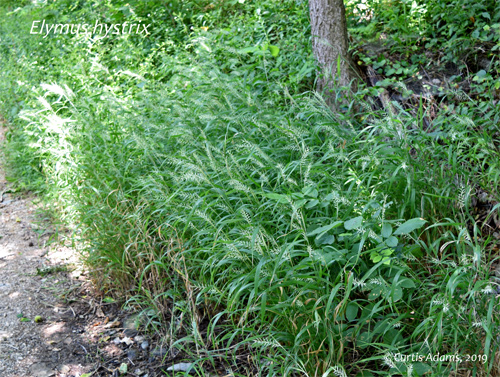Bottlebrush grass, Elymus
hystrix, is a pretty common native species found in open shade and woodland
edges in Maryland. Its native range is
from Maine to Georgia and westward to the Great Plains. It is a cool season grass, meaning that it begins
grows actively when soil temperatures are between 50 and 65 F. Attractive seed heads are produced in June
and these often persist into the fall.
Like most cool season grasses it shuts down in the heat of summer, but
comes back to life in the fall, sometimes staying green all winter. I am looking at using this grass to help fill in
the woodland edges after removing the invasive Japanese stilt grass, Microstegium vimineum. Ideally once it gets established it will grow
up and shade the ground before the stiltgrass germinates later in the spring.
 |
| Eastern Bottlebrush Grass at the end of June growing along a trail near Harper's Ferry, WV |
Rather than buying new seed, I harvested some from my existing
plants last October and stored them dry in a refrigerator at about 42-45 F. They were left there until I planted them in
mid-February under lights. Bottlebrush
grass seeds do not require moist stratification to get them to germinate, just
cold storage for a few months.
Since I have had less than stellar success with starting seeds I
thought I would compare different ways of planting the seeds and see how well
each germinated. This was a limited
study with only 8 seeds under each of 8 conditions. All were planted in a soil-less seed starting
mix and put on a warming pad to give a soil temperature between 65 and 70
F. The long awns on the seeds, which
give the brush effect, are not easily removed.
I pulled the awns off of each individual seed. For these I planted one set vertically, and
the next horizontally, each about a quarter inch deep. The third set I planted vertically about a
half inch down. I repeated these
conditions using seeds with the awn still attached.
 |
| Here's the first leaf of Eastern Bottlebrush Grass. The inital shoot has a reddish tinge that makes it harder to spot on the dark background. |
Seeds began germinating after 9 days. Rather than going into too many details the
results indicated that seeds that were cleaned germinated more quickly, but
after a month there was little difference between cleaned and uncleaned
seeds. Where I did see a difference was
with colder storage. Seeds stored in the
back of the refrigerator germinated at half the rate of the others stored at
about 44 F. I suspect at the back of the
frig, where the coldest air comes in, temperatures would sometimes drop below
32 F.
Now I have about 30 plugs of a native grass that I can grow on to use in my battle against stiltgrass.





